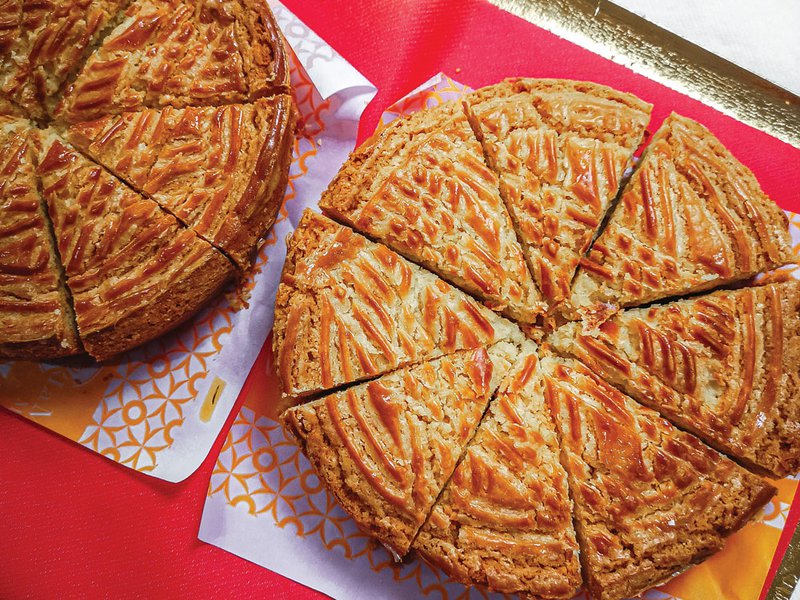A journey to France almost always equals delicious food and a compelling story about terroir and respect for ingredients
What is life without butter? It’s very likely that you’ll find this ingredient in every household kitchen, and for good reason. Slather it on toast, use it in baking, cook a delicious meal with it and so much more; butter is a real essential. It was on a journey to discover more about butter that I found myself in France. The country takes food – and certainly butter – seriously. Producing butter that delivers distinctive flavour profiles is a fi ne art, and there are plenty of farmers and cooperatives across the country dedicating themselves to this craft. The precision is awe-inspiring: in France, to be considered real butter, every 1kg of this dairy product needs to have a minimum of 82 per cent of fat. Allons-y!
SALTY DELIGHTS IN QUIMPER
My first stop was the cobbled streets of Quimper (pronounced ‘kemper’), an old city in Brittany in the north-west of the country. Known for its faience pottery, Quimper is built along meandering riverways with cobbled streets and leafy paths. A Gothic cathedral with twin spires is visible across the city and if you’re interested in learning more about the region, there are multiple museums where you can find and learn more about the traditional costumes of Brittany, regional art and, of course, pottery.
The city is also home to multiple manufacturing sites where milk from French cows is turned into butter, cheese and cream. Working with local farmers is of the utmost importance as are farms that treat their cows and terroir with all the respect and love they deserve. Certainly, the exploration of all things butter would be incomplete without visiting the farms where its journey starts. Just outside Quimper, I visited Ferme Bio du Gaec Tanguy, a family-run farm where the cows are free to roam as they like, listen to music when they are milked, and even get a mini-shower to help them relax. From there, it’s a peaceful drive along meandering French country lanes to get to the harbour town of Concarneau. A fishing port that’s well worth a day’s visit, I’d recommend taking a walk through the old walled town, Ville Close, which is located on an island connected to the harbour via a walkway.
The ramparts herald from the 14th century and overlook many fishing boats lining the docks. Inside the walled town, get lost amid the historical streets and drop in to Le Penfret for a well-deserved seafood feast. There’s always room for dessert and to work up an appetite, I headed to Atelier Larnicol where a masterclass awaited with a Meilleur Ouvrier de France, Georges Larnicol. Here, I learned how to make kouign-amann, a Breton cake made with three simple ingredients: dough, (salted!) butter and sugar. A simple dessert, but one where it’s best not to count the calories as the white sugar falls liberally into the dough.
NIGHTS IN NANTES
Moving east, Nantes, the sixth-largest city in France, was next on the itinerary. This historic town is flanked by the Loire and Erdre rivers and is a picturesque delight. There’s a lot to explore if you’re interested in history, from the Château des Ducs de Bretagne which used to be the Breton residence of the French monarchy and now houses the city museum, to the newly revamped Île de Nantes where food and drink are aplenty. Do make time to take a leisurely boat ride down the Erdre river; the views and peaceful environment are worth it.
Of course, what is a trip to France without the food? What I cannot recommend enough is a tasting menu at one Michelinstarred restaurant, Le Manoir De La Régate, headed by chef Mathieu Perou – who took over the restaurant from his father and grew up in the same structure that houses the restaurant. His newer restaurant in the centre of Nantes, Café des Expos, is also worth a visit. Mathieu has a fresh and sustainable approach to his menu at Le Manoir; items are locally sourced or produced on-site. He says, “Almost everything on the menu grows in this area. We also received a green Michelin star; it’s to award the fact that we use local products that are sustainable. We also received a distinction from the Michelin Guide for our service.”
I was lucky enough to participate in a cooking masterclass with Mathieu and his well-trained team. Freshwater pike perch is on the menu, and Mathieu says that the local fisherman practice ‘ikejime’, a method of killing the fish that maintains the highest meat quality. Using the pike perch along with lots of butter baked in clay crust, the final dish looked stunning and tasted delicious.
Mathieu, like many chefs, is keen to continue and nurture his relationship with the land. He works extensively with local farms including Gaec du Douet at La Pannetière. The farms I visited in Quimper and Nantes may have differed in acreage, but what stayed consistent was the treatment of the cows. Gaec du Douet, where I made an early morning stop, has less than 70 cows and only six people working the site. It was dark and cold as I left the hotel, but that’s because I was aiming to get to the farm for the best possible time: before the crack of dawn to witness the milking of the cows. After, I relished a thick slice of bread – just out of the oven – slathered with fresh butter.
What was fascinating, as I toured the cities and towns mostly across Brittany, is the prevalence of salted butter. And the reason is partly historical: the region used to be exempt from the salt tax that was levied across the rest of the country, so producers could use salt in their butter which also ensures the butter stays fresher for longer. It was easy to get lost in the dreamy quality of France’s countryside, but I managed to spend a day in Paris before heading home. It was then, as I ate a perfectly buttery croissant at breakfast and a flaky pastry in the afternoon, that I looked back with deeper appreciation of all the hard work that went into making French butter.







